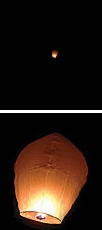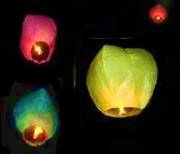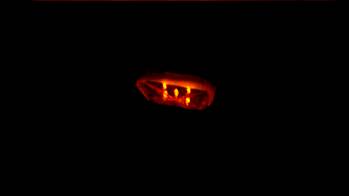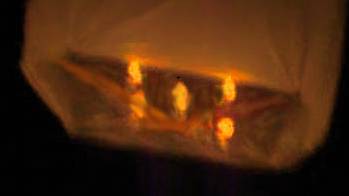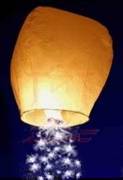THE MOST CONVINCING PRANK
WHAT FIRE BALLOONS CAN AND CANNOT DO
The prank candle balloon (fire balloon) has been and is a frequent cause of unidentified flying object
(UFO) sightings. They have been used by kids to cause UFO sightings. This was especially true in the
1960s, after an article describing their construction appeared in a science experimentation magazine.
They do a good job of scaring the bejeebers out of many people who see them. The following is a
description of the fire balloon, how it behaves, and why it fools so many people:
A fire balloon is a folk toy, dating from the 19th century. It is also called a candle balloon. They
have been implicated in some of the 1897 "airship" sightings. It is possible that this is
the first time they were used to make people see unidentified flying objects. No one would have thought
seriously of airships before then.
The fire balloon actually dates to the 14th century, where they were used as prayer balloons. These
are called sky lanterns. In the US, fireworks companies started selling them a few years ago. So you
can now buy your own UFO.
There are four types of true fire balloons, plus one hybrid type:
- Type I - The original: This was made of tissue paper, string, and a paper or tin cup of oil or
tallow with a cloth wick. The disadvantage of this design was that it fell in a ball of fire if
the tissue paper or paper cup caught fire, setting fire to whatever it landed on. The usual flying
time is 30 minutes to an hour.
- Type II - The newer design: This uses a dry-cleaning bag sealed at the top with Scotch tape. The
bottom is held open with drinking straws or balsa wood, and candles are taped or melted to these.
The heat from the candles makes the bag fill with hot air and fly. These usually fly 10 to 20
minutes.
- Type II A - A commercial design: This is the commercially available Sky Lantern, sold by
fireworks stores. They work the same as the type II, except they use a wax-coated square of
cardboard instead of candles. They fly 5 to 10 minutes. Photos appear below, in flight, and just
after launch.
- Type III - The long-life version: Several dry-cleaning or cheap trash bags are split and
Scotch-taped together to make a larger bag. The huge new leaf pickup bags might also work. Church
candles are used in these, and they can fly for over two hours. Good trash bags are too heavy to
fly. The thin bags that split apart and spill your garbage on the cat when you try to pick them
up are the ones that fly well.
- Type IV - The bright version: This is constructed like the long-life version, except that small
emergency flares are substituted for the candles. These usually last 15 minutes, half an hour, or
an hour, depending on the flares used. The light is more brilliant and colorful from these.
- Type H - A gas balloon is the lifting device, and flares are used just to make light.
DANGER: DO NOT MAKE OR FLY THESE. They will set fire to a forest, a crop, brush, somebody's
house, or a building. They are illegal in most places. At least three UFOs have been blamed for
house fires. One burned down a church. Several others caused brush and crop fires.
Here is a list of what fire balloons have been observed to DO:
-
They do not look like balloons at night. The bag either is lost to sight, or makes a glow or
projection appear above the object. Often the witness sees the bag as a dome.
- They look like a single light, a ring of lights, or a row of lights.
- Fireworks companies are now selling Type II A fire balloons (right). An
example is the Surenkamp Fireworks "Hand Crafted Authentic Chinese Sky Lanterns" stock
number PFN0110. So expect plenty of sightings.
(The top photo is a distant sky lantern. The bottom photo is one that has just been launched
close to the photographer.)
- They can appear to have rectangular windows below the lights, and some form of structure (many
times described as a fin or a dome) can appear above the lights. The balsa wood strips or drinking
straws reflect the candlelight and look like windows. The bag can reflect light, and look like an
irregular structure. A halo around the light, "golden rooms", and a
"peace sign" shape, have been reported.
- The ones for sale usually do not show a structure at the bottom except for a central dark
area where the cardboard square is.
- They are usually red, orange, yellow, or white. They can change from one color to another.
Sometimes, when a blue cleaner bag is used, the lights can look green or blue, or change color.
The colors can appear to be quite vivid at night.
- Metallic salts added to the candle wax can change the color of the flame.
- The ones for sale (above) have bags made in many colors. But many have an orange glow
visible in addition to the bag color.
- Some of the latest ones for sale have multiple colors or images on them. One is being
sold with an American flag image.
- They can maneuver: wobble, flutter, move like a falling leaf, or
swing like a pendulum. Changes in wind speed make the bag tilt, as the heavier bottom lags behind
the top (due to inertia). This gives rise to the concepts of ultra-maneuverability and
non-ballistic behavior of UFOs. Since only the bottom of the balloon is visible, it seems to
require a lot of energy to behave as it does. After the change tilts the bag, it rocks back and
forth until it settles out. Note that although they can do this, they do not have to do this.
Notice the different amounts of tilt in the photo of color sky lanterns (above right) due
to wobble.
- The usual number of candles is 1, 2, 3, 4, 5, 8, or 9. Additional lights can be produced by
reflections off the straws or the bag (A 5-candle one is at right).
- They seem much bigger and much farther away than they are. Since most sighters think they are
vehicles, they make them appear in their minds to be at least as big as a car. To make the image
seem that big, they see the object as farther away than it is.
- Remember that nobody can determine the distance of an unfamiliar object seen against the
sky if it is farther away than 30 feet, unless it overlaps an object of known distance.
- Since they seem farther away, they also seem faster, apparently going at fantastic speeds, and
maneuvering tightly enough to kill human pilots.
- Since they have candles aboard, the lights pulsate as the candles gutter when the wicks get too
long. The lights can dim in quick sequence if a gust of wind hits the mouth of the bag.
- They can rotate about a vertical axis. This makes the lights appear to rotate like a slow
Frisbee.
- The witness usually sees the rotation from below because the object is flying.
- This can also make the lights seem to blink on and off (A simulation is at right).
- Parts of the structure of the fire balloon can hide the candles that are farther away.
- Often the rotation is not uniform, but erratic,
- The mechanics of this rotation can be seen at rotation
- They can appear to approach and recede from the witnesses, as the candles burn brighter and
dimmer.
- They can appear to move against or cross to the wind, if the upper air wind is blowing in a
different direction than the surface wind.
- They don't make any sound, unless the prankster installs whistling fireworks, or a firecracker
to terminate the sighting with an explosion. These have been reported.
- They can appear to drop bombs, send scout ships, or fire missiles at the ground. This happens
in two ways:
- Dripping candle wax burns as it falls.
- A candle melts itself free of its support and falls while burning.
(The structure and positions of candles are seen at right)
- They can land and take off. If the wind gusts and the bag tilts enough to lose hot air, the
balloon will land until the hot air builds up again. This can also set a fire if the balloon lands
in the wrong place. This can produce burned landing marks and other
"physical evidence."
- They can follow high tension power lines. This happens when the power lines are in a linear
clearing cut through trees. The wind will follow the clearing, pulling the fire balloon along
with it. This can happen even if the fire balloon is somewhat above the trees, because those wind
effects also exist somewhat above the tops of the trees.
- They can suddenly appear in the sky. Two methods are known to delay the appearance of the light
until the balloon is far from the launch site. One is to put a black paper cone around the candles.
It burns away when the flame reaches the paper. The other is to use a fuse to start a much brighter
flare.
- They can appear to rush away from the witness at high speed as the last candle goes out. If the
last candle burns out, it will appear to rush directly away from the witness. If the last candle
falls, it will appear to rush either down, or toward the distant horizon. Fire balloons can also
suddenly ascend rapidly once they have shed enough weight in candle wax.
- Some pranksters hang strips of aluminum foil from the balloons. These appear as appendages,
sparkle in reflected light, and make the balloon appear on RADAR.
- They can give off bursts of brilliant colors, balls of light, or showers of sparks if the
prankster puts in lightweight fireworks. One particularly striking effect occurs when the
"signal flare" firework (which gives out extremely bright flashes of light) is
used.
- They can disappear in a ball of flame if the envelope catches fire.
- They can explode noiselessly (or with a delayed bang) in a shower of sparks if the prankster
puts a small firecracker in.
- Fire balloons are low power devices, and generally fly low. They often follow wind patterns as
trees deflect the air currents. In some cases, they follow power lines because of the swath cut
in the trees for the power lines to run through.
These are NOT examples of fire balloons:
- Anything that goes behind a normally high cloud and reappears.
- Anything bright seen during the day. (Note that type 1 can be seen in daylight as a dark object,
but other fire balloons usually are not flown during the day.)
- Anything moving against known low and medium altitude winds.
- Anything crossing the open sky in less than two seconds.
- Anything crossing the open sky back and forth several times.
- Anything tracked on RADAR at high speeds (but a visual fire balloon sighting may be erroneously
linked with a high-speed RADAR anomaly).
- Anything higher than 20000 ft.
- Anything seen over the ocean out of sight from land is probably not a fire balloon (due to the
lack of a launching site).
These are examples of witness statements describing fire balloons:

- "It was 80 to 90 feet across." (It was actually about 1.5 ft across.)
- "Blimps with fire at one end." (Good description)
- "It was like looking into the middle of hell."
- "There was an area of stronger density above it."
- "A slow moving ball of fire."
- "An inverted bowl."
- "Lights whirling around the rim." (right)
- "Reddish white, the apparent size of a car."
- "Blue lights, the color of a welding torch, in a band around the center."
- "It vanished in the distance."
- "A snake-like thing fell from the bottom." (Candle fell)
- "It moved haphazardly."
- "One quarter to one half the size of the full moon."
- "Firing rockets at the ground." (flares burned free and fell)
- "It swung like a pendulum."
- "It shot away when I turned the spotlight on it."
- "It zipped along at fantastic speed."
- "It moved like a falling leaf."
- "The lights appeared to be on the rim of a rapidly rotating disk." (right)
- "Several observers reported the smell of perfume in the air." (Scented candles?)
- "It looked like a two story house, with flying golden rooms and partitions."
- "It moved like a leaf fluttering from a tree."
- "It was rocking back and forth on its axis, still absolutely silent."
- "Several silverish things were hanging down from it."
- "Square windows around the bottom."
- "When I shined my light at it, it swung like a pendulum, apparently in recognition."
- "Where does it go in the daytime?"
- "At times the light seemed to change. Pulsate."
- "It wasn't real bright, but it was fuzzy."
- "The center of it looked like a hippie peace sign."
- "Now I describe it as being beautiful."
- "Suddenly it shot straight up, disappearing in a couple of seconds."
- "It rippled like looking through water."
- "There were lights on the bottom going around it like pinwheels. Red ones."
- "They looked like merry-go-rounds, all lit up and turning."
- "Then I had an idea. I cast my fishline, caught it, and reeled it in. Here it is."
The number of cases proven to be caused by fire balloons is amazingly large. Every time a major
UFO "flap" happens, at least one fire balloon is found by police.
As you can see, many of the antics of UFOs seen from the ground can be explained by fire balloons.
By no means can they explain all sightings, but a large number of moving lights at night, or rings
of lights, have been shown to be these devices.
The type H fire balloon is a similar, but brighter device. It consists of one to four highway
flares attached to a helium-filled government-surplus weather balloon. These generally fly higher,
and are seen over a wider area.
LINKS:

